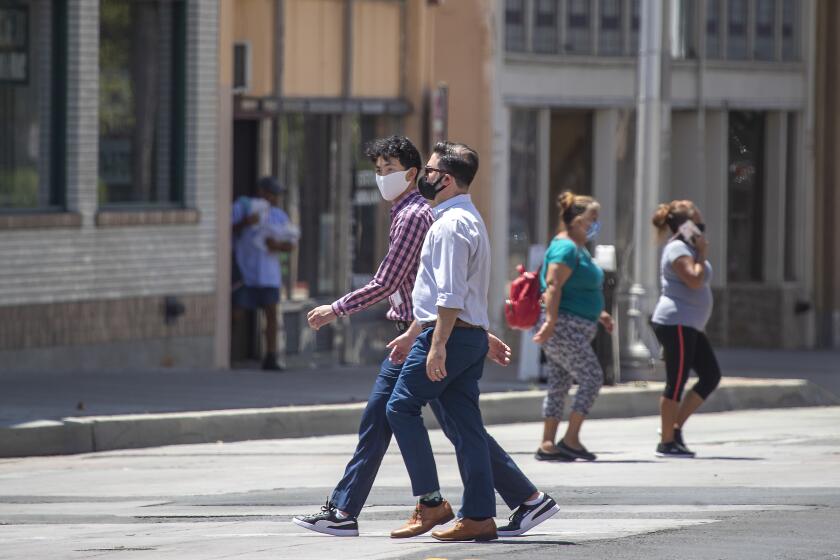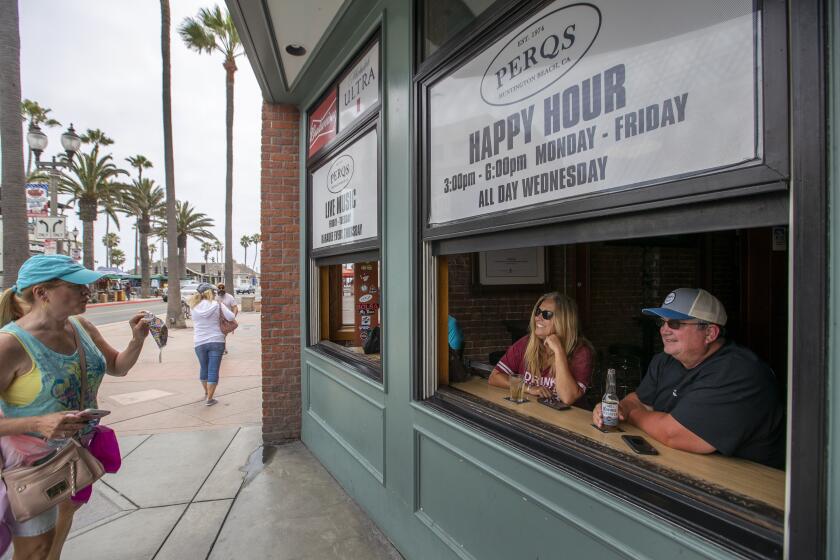Orange County initiative aims to address root causes behind Latinos’ high risk for COVID-19
- Share via
Orange County health officials on Thursday reported the countywide coronavirus infection rate stands at about 245 residents per 100,000 — a total of 21,517 cases — but in areas with predominately Latino populations, the rates are much higher.
In Anaheim, where census figures indicate Latinos account for 54% of the population, the transmission rate is 1,065 per 100,000. And in Santa Ana, which has a 77% Latino population, the rate climbs to 1,214 — nearly five times the countywide rate.
To respond to an apparent emerging healthcare crisis in “hot spot” neighborhoods disproportionately affected by COVID-19, county officials are teaming up with a network of area nonprofits and agencies to provide education, resources and virus testing to communities that need it most.
The Latino Health Equity Initiative will take advantage of existing service infrastructures and build upon them to reach vulnerable residents “at an almost personal level,” said Orange County Board of Supervisors Vice Chairman Andrew Do, who launched the effort June 30 alongside 4th District Supervisor Doug Chaffee and partnering organizations.
Do said the effort will address the many barriers that keep people from accessing information or acting on information that they have — from income and transportation concerns to immigration status and distrust of government agencies.
The increase has prompted hospitals in the region to begin to prepare for a surge of sick patients, according to the director of the Orange County Health Care Agency.
“With the Latino community, we know they are a large part of the essential workforce we rely on in Orange County,” he said. “When you couple that with dense living environments and multi-generational households you have a confluence of risk factors and also a vulnerable population.”
Do’s 1st district includes Santa Ana and portions of north Fountain Valley, while Chaffee represents Anaheim, La Habra and Placentia, among other neighborhoods.
The work of the initiative will be overseen by Latino Health Access, a Santa Ana nonprofit that since 1993 has employed a small army of promotoras to advocate for health and well-being directly in the neighborhoods in which they reside.
On Monday, the group offered free drive-up coronavirus testing at Santa Ana’s Walker Elementary School to some 300 city residents under the banner of the initiative. Similar events are planned next week elsewhere in Santa Ana and Anaheim.
Dr. America Bracho, chief executive of Latino Health Access, was part of a small group of advocates who actively campaigned county health leaders to disaggregate coronavirus statistics to provide a clearer picture of where obstacles to health education and prevention were most persistent.
“It was like a big wave coming. We were absolutely desperate seeing the numbers,” Bracho said of a rapidly rising coronavirus trend among Latinos. “We said we needed to have data by ZIP Code, and we had to have hot-spot strategies in those cluster areas so we can stop this.”
By June 26, the Orange County Health Care Agency began reporting information by neighborhood and eventually released city-specific figures on the number of COVID-19 deaths.
Public health experts say wearing a mask can prevent the spread of COVID-19, but in Orange County many are still skeptical.
Bracho said the initiative will aim to reach vulnerable individuals with important information about virus protection and prevention.
It will also focus on creating more materials in Spanish, making more tests available, teaching people what to do if and when they become infected and “multiplying leadership” by training hundreds of local youth and adults to disseminate information among their social and professional networks.
Bracho admits the newly launched initiative is attempting to respond to circumstances constantly shifting and changing in real time.
“We have been building the plane while we’re flying it,” she said. “[But] my hope is that we can decrease the growth in the number of cases and reach a level of transmission that allows us to go to a semi-normal life.”
Speaking at a June 30 news conference announcing the launch of the Latino Health Equity Initiative, Chafee shared his confidence the effort could be a model for the future.
“It looks like a very successful venture we’re about to start,” he said. “If this works, it will be a pilot program that we can apply to other hot spots and throughout the county.”
All the latest on Orange County from Orange County.
Get our free TimesOC newsletter.
You may occasionally receive promotional content from the Daily Pilot.






